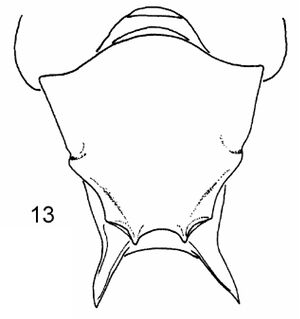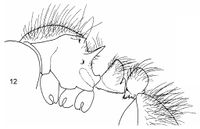Meranoplus orientalis
| Meranoplus orientalis | |
|---|---|

| |
| Scientific classification | |
| Kingdom: | Animalia |
| Phylum: | Arthropoda |
| Class: | Insecta |
| Order: | Hymenoptera |
| Family: | Formicidae |
| Subfamily: | Myrmicinae |
| Tribe: | Crematogastrini |
| Genus: | Meranoplus |
| Species: | M. orientalis |
| Binomial name | |
| Meranoplus orientalis Schödl, 2007 | |
Restricted to southern Queensland.
Identification
Schödl (2007) - Doubtless M. orientalis is closely related to Meranoplus duyfkeni. However, apart from the completely different distribution there are distinct characteristics that clearly separate the two taxa. The clypeus in orientalis occasionally shows an additional anterio-median blunt bulge, the promesonotum is never translucently flanged and its dentition is either absolutely missing or, in specimens from Morven, slightly more clearly developed but still very similar to that of the type.
Keys including this Species
Distribution
Distribution based on Regional Taxon Lists
Australasian Region: Australia (type locality).
Distribution based on AntMaps
Distribution based on AntWeb specimens
Check data from AntWeb
Countries Occupied
| Number of countries occupied by this species based on AntWiki Regional Taxon Lists. In general, fewer countries occupied indicates a narrower range, while more countries indicates a more widespread species. |

|
Estimated Abundance
| Relative abundance based on number of AntMaps records per species (this species within the purple bar). Fewer records (to the left) indicates a less abundant/encountered species while more records (to the right) indicates more abundant/encountered species. |

|
Biology
Castes
Worker

| |
| . | |
Nomenclature
The following information is derived from Barry Bolton's Online Catalogue of the Ants of the World.
- orientalis. Meranoplus orientalis Schödl, 2007: 398, figs. 12, 13, 58, 80 (w.) AUSTRALIA (Queensland).
- Type-material: holotype worker, 5 paratype workers.
- Type-locality: holotype Australia: Queensland, 6 mi. W Blackwater, 26.iii.1962, series A95(J.E. Dowse); paratypes with same data.
- Type-depositories: ANIC (holotype); ANIC, NHMW (paratypes).
- Distribution: Australia.
Unless otherwise noted the text for the remainder of this section is reported from the publication that includes the original description.
Description
Worker
Holotype. TL 6.0, HL 1.58, HW 1.79, FC 1.43, CS 1.68, SL 0.98, SI1 55, SI2 58, PML 1.20, PW 1.48, PMD 1.48, PMI2 100, ML 1.70, PTLL 0.50 PTLH 0.65, PTDW 0.63, PPLL 0.45, PPLH 0.70, PPI 64, PPDW 0.64, PT/PP 98.
Mandible with four teeth. Clypeus in full face view bluntly bidentate additionally carinulate, denticles not or only weakly surpassing anterolateral corners of frontal carinae. Head wider than long (CI 115) with the preoccipital corners evenly rounded and the rear margin shallowly concave. Frontal carinae posteriorly parallel-sided, more evenly and not as broadly and translucently narrowing towards clypeus, still distinctly narrower than head width (FI 125). Antennal scrobe in lateral view reaching far beyond middle of length of head posteriorly, distinctly carinulate in whole length, with additional distinct microreticulum, posteriorly ill defined from remainder of head. Genae below scrobal margin and ventrolateral sides of head carinate, preoccipital lobes reticulate. Compound eyes moderately large (EL 0.34, REL 0.21, with 19 ommatidia in the longest row) in lateral view situated slightly behind middle of lateral sides of the head, dorsal ocular margin touching ventral scrobal margin.
Promesonotum trapezoidal, wider than long (PMI 123) without developed shield, propodeal declivity visible from above. Promesonotal projections almost completely reduced with posterolateral spines bluntly triangular and the posterior projections as short denticles. Propodeal spines of medium length (PSL 0.53) situated above middle of length of declivity, massively built, acute and straight and distinctly diverging in dorsal view.
Petiole higher than long (PTI 77), in profile triangular with anterior face straight and unsculptured, the posterior face convex, regularly costate. Postpetiole elongately nodiform, with medium sized ventral tooth. First gastral tergite entirely microreticulate, with interspersed glossy spots, basally an indistinct fine striation may be apparent. Dorsum of head costate, with indistinctly developed microsculpture, frontal margins irregularly sculptured. Promesonotal shield regularly elongately rugose. With pilosity similar to that of preceding species.
Concolorous brown to fuscous.
(n = 4). TL 5.85-6.90, HL 1.38-1.58, HW 1.58-1.83, FC 1.30-1.45, FI 121-126, CI 113-116, CS 1.48-1.70, SL 0.90-0.98, SI1 53-57, SI2 57-61, PML 1.13-1.25, PW 1.33-1.53, PMI 118-125, PMD 1.30-1.55, PMI2 98-102, ML 1.50-1.75, PSL 0.50-0.59, PTLL 0.43-0.50, PTLH 0.59-0.71, PTI 70-77, PTDW 0.53-0.63, PPLL 0.43-0.45, PPLH 0.65-0.73, PPI 62-65, PPDW 0.61-0.64, PT/PP 82-98, EL 0.29-0.34, REL 0.20-0.21, with 17-19 ommatidia in the longest row.
Type Material
Named for its easterly distribution.
References
- Schödl, S. 2007. Revision of Australian Meranoplus: the Meranoplus diversus group. Memoirs of the American Entomological Institute 80:370-424.
